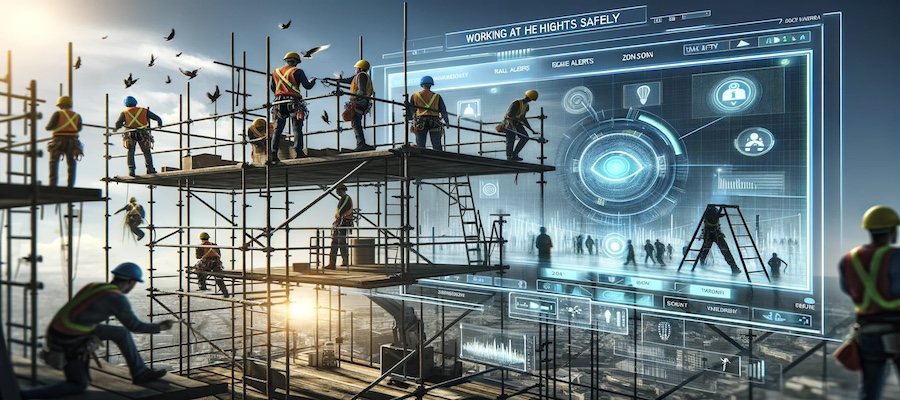Working at Heights Safety: Video Analytics Revolution in Construction

Working at heights remains one of the most hazardous activities in the construction, maintenance, and utility services industries. Traditional safety measures, while essential, have limitations in proactively preventing accidents and ensuring workers' safety. The advent of video analytics technology offers a promising enhancement to these safety measures, providing real-time monitoring and advanced hazard detection.
The Rise of Video Analytics in Construction Safety
The construction sector, known for its massive scale and intricate operations, also has a record of being one of the least innovative industries globally. However, technological advancements like video analytics are disrupting this trend. Video analytics technology analyzes video feeds to detect events and generate alerts, significantly enhancing operational capabilities in construction sites.
Key Features of Video Analytics for Height Safety
Video analytics systems offer numerous benefits, including real-time analysis and automated alerts, which increase awareness and enable swift action on unsafe acts. Key features include detecting congregation of workers, vest color-based zoning, hard hat and safety vest detection, and monitoring workers under lifted loads. These features enable safety officers to be aware of violations and hazards without being physically on site, allowing for prompt and effective action plans.
Implementing video analytics in construction sites has shown marked improvements in worker safety and productivity. Real-time analysis of camera feeds allows for continuous monitoring of work progress, creating videos and reports crucial for meetings and progress claims. This reduces the need for regular site visits by directors and assists project managers in monitoring progress and dispute resolution.
Implementing Video Analytics: A Step-by-Step Guide
Implementing video analytics in construction, especially for working at heights, involves several key steps:
- Assessment and Planning
- Assess the worksite to identify key areas and activities that require monitoring.
- Plan the placement of cameras for optimal coverage and effectiveness.
- Choosing the Right Equipment
- Select cameras and hardware that suit the environmental conditions of the site.
- Ensure the equipment has features like night vision or weather resistance, if necessary.
- Installation and Setup
- Install cameras and any necessary network infrastructure.
- Configure the video analytics software, integrating it with the camera system.
- Defining Safety Protocols and Policies
- Set up specific safety policies within the analytics software (e.g., hard hat detection, exclusion zones).
- Tailor these policies to address the unique risks of working at heights.
- Integration with Existing Safety Measures
- Ensure that video analytics complement, not replace, existing safety protocols.
- Integrate the system with other safety measures like alarms or emergency response procedures.
- Training and Familiarization
- Conduct training sessions for workers and safety personnel on how to use and respond to the video analytics system.
- Ensure everyone understands the role of this technology in enhancing safety.
- Testing and Calibration
- Test the system thoroughly to ensure it accurately detects safety hazards and triggers alerts.
- Calibrate the system as needed to reduce false positives and improve accuracy.
- Ongoing Monitoring and Maintenance
- Regularly monitor the system's performance and effectiveness in real-time safety management.
- Schedule routine maintenance to ensure the hardware and software continue to function optimally.
- Data Analysis and Improvement
- Analyze the data collected by the system to identify trends and areas for safety improvement.
- Make adjustments to safety policies and training based on these insights.
- Review and Update
- Periodically review the system's effectiveness and update it as new technology or features become available.
- Adapt the system to changes in the worksite or construction practices.
By following these steps, construction sites can successfully implement video analytics systems to enhance safety, particularly in high-risk activities like working at heights.
Challenges and Solutions
Implementing video analytics for working at heights is not without challenges. These include understanding the complexity of tasks at height, overcoming environmental constraints like variable lighting and inclement weather, addressing privacy and data security concerns, integrating the technology with existing safety protocols, navigating the cost implications, and addressing the technological learning curve. Solutions involve adaptable and sophisticated systems, privacy safeguards, comprehensive training, and support during the transition phase.
The future of construction safety is increasingly leaning towards the integration of AI and video analytics. This technology is set to evolve, becoming more adaptable to the unique demands of high-risk tasks like working at heights. As the technology advances, it will continue to play a crucial role in enhancing safety and operational efficiency in the construction sector.
Video analytics technology is revolutionizing the way safety is managed in construction, especially for high-risk activities like working at heights. While challenges exist, the benefits in terms of improved safety, increased productivity, and enhanced site visibility are undeniable. As the construction industry continues to embrace these technological advancements, we can expect to see a significant reduction in accidents and an overall safer working environment.